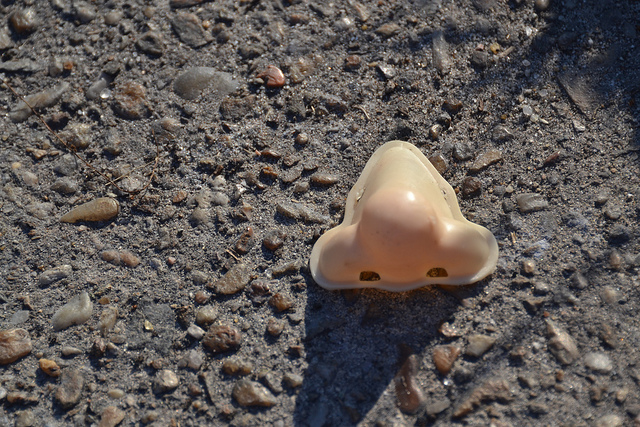 Evolution & Behaviour
Evolution & Behaviour
How environment shapes…your nose

An important function of the human nose is to warm and humidify the air that we breathe in. This is important so as to prevent the inner respiratory tract from drying up, which can lead to infections. Because the shape of the nose and the geometry of the inner airways are tied to the efficiency of the air-conditioning process, it is thought that these traits might have been shaped in part by natural selection. This could help explain some of the variation in nose shapes and sizes across human populations living in different climates. Indeed, several studies looking at variation in the shape of the nasal aperture and internal nasal cavity in human skulls across different environments have shown that this might be true. For example, the nasal aperture in the human skull tends to be larger, on average, in warmer climates and narrower in cooler climates.
There is another evolutionary reason, besides natural selection, that can explain why people from across the globe have widely varying nose shapes: genetic drift. Genetic drift is the name given to the accumulation of genetic differences among isolated populations. Because of the link between genotype (the genetic background of every individual) and phenotype (the physical manifestation of the genotype), genetic drift also leads to physical differences between populations. In fact, we know, based on DNA sequence variation in the human genome and our knowledge of human demographic history, that genetic drift has had a large influence on human evolution. Because of this, we asked: Could genetic drift alone explain the differences in nose shape among human populations? We compared the variation in seven measurements of nose shape both within and among four groups: West Africans, East Asians, Northern Europeans, and South Asians. Out of the seven traits we looked at, we found that the differences in the width of the nose and nostrils among the four populations cannot be explained by genetic drift alone. Varying natural selection pressures could have driven these traits to look different in geographically distant populations.
Then the question became: Could climate be the selection pressure under question? To answer this, we evaluated how closely, if at all, nose width/nostril width variation followed the geospatial variation in temperature and humidity. We found that nostril width is positively correlated with both temperature and humidity, to the effect that wider nostrils are more common in warmer climates and narrow nostrils are more common in cooler climates. This trend is similar to previous findings that the width of the nasal aperture (in the skull) is positively correlated with temperature and humidity.
How does having narrow nostrils benefit us in cold weather and vice versa? Based on research on fluid dynamics of air in different geometries of the nasal cavity, we know that air entering the airways tends to get more turbulent if the airways are narrow. This turbulence is thought to promote better "mixing" of the air and the mucosal membranes lining the nasal cavity. As such, narrower airways might have been beneficial in cooler climates and may have been less important, or even detrimental, in hotter climates.
Why does this matter? Human adaptation is important for understanding prevalence of various health risks. For example, the risk of skin cancer is higher near the equator. Darker skin has more melanin, a natural sunscreen, which helps to reduce this risk. Hence people near the equator tend to have more melanin in their skins. However, far away from the equator, it is important to be able to absorb enough ultraviolet light to trigger the synthesis of vitamin D. Thus, people away from the equator tend to have be lighter. We understand the link between climate, skin pigmentation, and health better today because of a better grasp of adaptation. While the relationship between nose shape and climate isn't as strong or clear as that for skin pigmentation, it might be associated with the risk of respiratory infection and disease, which is also important from a medical perspective.
Original Article:
Zaidi A, Mattern B, Claes P, McEcoy B, Hughes C, Shriver M. Investigating the case of human nose shape and climate adaptation. PLOS Genetics. 2017;13(3):e1006616. doi:10.1371/journal.pgen.1006616.Next read: Nitrogen pollution from lowlands reaches distant mountain lakes by Beth Hundey , Katrina Moser , Fred Longstaffe
Edited by:
Massimo Caine , Founder and Director
We thought you might like
Why some forests burn better than others
May 19, 2015 in Earth & Space | 4 min read by Elisa Dell'AglioTara Oceans Expedition sequences the ocean
Nov 24, 2015 in Earth & Space | 4 min read by Chris BowlerOcean acidification and its effects on coral reef growth
Jul 8, 2016 in Earth & Space | 3.5 min read by Rebecca AlbrightResetting nature’s clock: shifting seasons and species relationships
Sep 14, 2016 in Earth & Space | 3.5 min read by Stephen Thackeray , Sarah BurtheMore from Evolution & Behaviour
Cicada emergence alters forest food webs
Jan 31, 2025 in Evolution & Behaviour | 3.5 min read by Martha Weiss , John LillSize does not matter: direct estimations of mutation rates in baleen whales
Jan 29, 2025 in Evolution & Behaviour | 4 min read by Marcos Suárez-MenéndezThe Claws and the Spear: New Evidence of Neanderthal-Cave Lion Interactions
Jan 22, 2025 in Evolution & Behaviour | 3.5 min read by Gabriele RussoA deep-sea spa: the key to the pearl octopus’ success
Jan 20, 2025 in Evolution & Behaviour | 3.5 min read by Jim BarryFeisty fish and birds with attitude: Why does evolution not lead to identical individuals?
Aug 31, 2024 in Evolution & Behaviour | 3 min read by Lukas Eigentler , Klaus Reinhold , David KikuchiEditor's picks
Trending now
Popular topics


